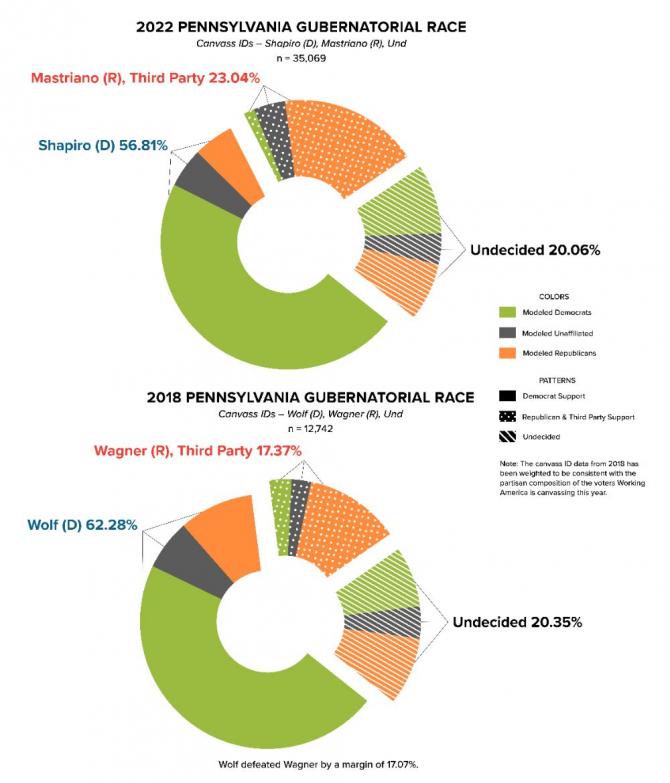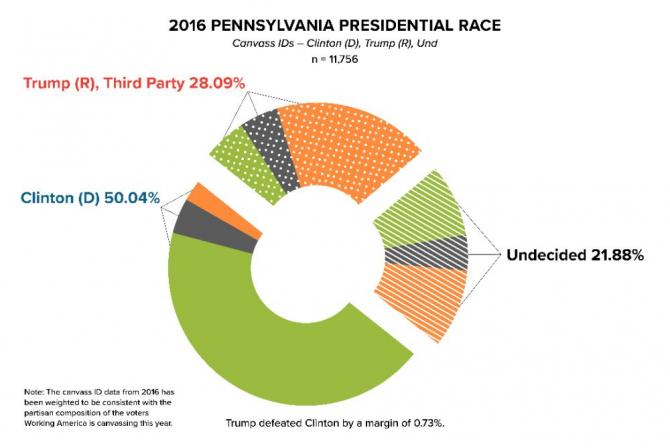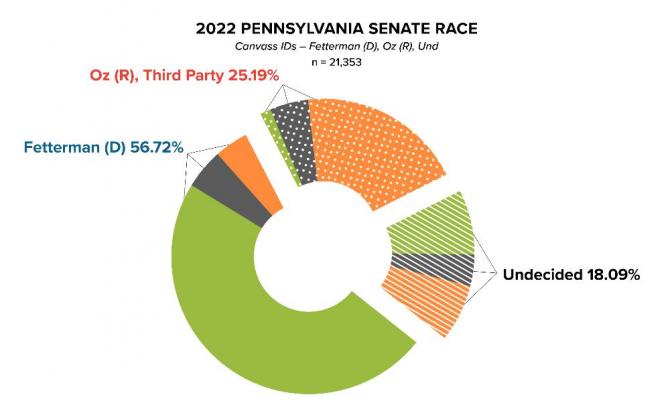Chip in Now to Stand Up for Working People
Working people need a voice more than ever and Working America is making that happen.
Working people need a voice more than ever and Working America is making that happen.
Matt Morrison
10/03/2022
Elections for governor and U.S. Senate in the Keystone State have enormous implications for the country not only in 2022, but also in 2024.
We are optimistic, but see real risks. Both statewide Democratic candidates — Josh Shapiro for governor and John Fetterman for Senate — appear to be on sound footing according to our data and the expert election prediction sites.
Likely Democratic voters share a strong revulsion for GOP extreme gubernatorial candidate Doug Mastriano, and are unified, but less strident, in their unfavorable opinions of GOP Senate candidate Mehmet Oz.
But likely Republican voters are coalescing around Mastriano and Oz to a far greater extent than they did with Republican candidates four years ago. (Oz is slightly outpacing even Trump among this segment.)
Why we are cautious: Based on historic trends, we expect the 2022 electorate to be the most Republican-leaning since 2014. With the notable exception of 2018’s Democratic wave, the share of ballots cast by likely Democrats typically decreases (by an average of 2.2 points) and likely Republicans typically increase (3.8 points) in a midterm compared to a presidential election.
We compare the Shapiro and Fetterman coalitions to each other, as well as to Gov. Tom Wolf’s successful 2018 reelection and Hillary Clinton’s narrow 2016 loss.
Shapiro’s Path
Experts predict a 91% chance of a Josh Shapiro win. That may be an aggressive bet, but not necessarily wrong. Many voters told us that his Republican opponent, MAGA standard-bearer Mastriano, is “too crazy” to earn their support. And that is coming from republicans in the Philadelphia collar counties. As canvassers told me today, these voters are against Mastriano more than they are for Shapiro.


In addition to the mood of voters, we can look at the math. Similar to last week’s Michigan report, we group voters by their candidate choice in the election (the patterns) and then by their partisan identity (the colors). Shapiro’s 57.1% support among our sample is 5.7 points behind Wolf’s 2018 benchmark. He is doing as well as Wolf among likely Democrats, but draws less support from unaffiliated voters and likely Republicans.
Mastriano is doing 5 points better than his GOP predecessor Scott Wagner, driven by a strong consolidation among likely Republicans of +5.7 points in our sample, marginally more support from unaffiliated votes, but less support from likely Democrats.
Even with this increased polarization, Shapiro is claiming 17% of likely Republicans (compared to Wolf garnering 31% of this segment). Another positive indicator is the comparison to the narrow 2016 loss (-0.7 points) in the state’s presidential vote. Shapiro is running 6.4 points ahead of Hillary Clinton, stronger among likely Democrats, unaffiliated and likely Republican voters. Mastriano lags Trump’s benchmark by 5.5 points.


But there are differences in the Democratic coalitions between the gubernatorial and U.S. Senate contests.
Fetterman: Strong with the Base
Pollsters are only 82% confident of a Fetterman win. Our canvass data shows the candidates are garnering nearly identical support (57.3% for Fetterman versus 57.1% for Shapiro). Fetterman enjoys more support from likely Democrats than Shapiro (1.7 points), but has less crossover appeal to likely Republicans (-1.2 points).


However, Fetterman’s challenge is the relative strength of his GOP opponent, TV’s Dr. Oz. In any other context, a doctor who promotes hydroxychloroquine to treat COVID would, similar to Mastriano, be seen as “too crazy.” But Oz appeals more to likely GOP and unaffiliated voters. Canvassers report that the biggest objection to Oz is that he lives in New Jersey. And unaffiliated voters told us that Fetterman’s health is a chief concern due to his stroke in March. And in what may be one of the more artful pivots of the cycle, some GOP voters are echoing Tucker Carlson’s claim that Fetterman is mentally compromised.
Likely Democratic voters actually choose Fetterman at higher rates than Shapiro, higher even than Wolf in 2018. But likely Republican and unaffiliated voters have moved away from Fetterman compared to Wolf in 2018 (although Fetterman is doing better than Clinton).
Among unaffiliated voters, Fetterman (-0.23 points) and Oz (0.56 points) are fairly close to the support levels of their party standard-bearers in the gubernatorial contest.
But among likely Republicans, Oz garners more support than Mastriano as well as Trump in 2016.
See the full comparison here.
The More Conservative Electorate
The 2022 electorate will likely include a larger share of likely Republican voters, and fewer likely Democrats, compared to the 2018 and 2016 electorates we are using to benchmark candidate support. Since 2010 — with the exception of the wave election of 2018, circumstances not likely to repeat this year — the pattern in midterms compared to presidential years, the share of ballots cast by likely Democrats decreased and likely Republicans increased — an average partisan shift of 6.1 points toward GOP-leaning voters. To put the size of this shift in perspective, President Joe Biden won Pennsylvania by a 1.2-point margin.
How We Impact the Race
Working America canvassers, back on the ground here since early 2021 (after a yearlong hiatus due to COVID) are building on our history in the state dating back to 2005. More than 1 in 10 likely Pennsylvania voters are now Working America members. In just the last five weeks, organizers have had more than 35,000 face-to-face persuasion conversations with voters — and heard a lot of opinions about the candidates.
Securing undecided voters in both contests is essential. The good news is that this organizing scale combined with hundreds of randomized control trials just this year measuring Working America’s impact on voters’ opinions, deployed at full strength, will boost Shapiro and Fetterman’s margins by more than 68,000 votes — a swing equal to 1.5 to 2 points of the statewide margin in the typical midterm.
Next Up: What We Know About Undecided Voters
In our next report, we will take a look at the issues that motivate Undecided voters with a spotlight on Arizona, discovering what they care about and unpacking the tools we use to influence them.
As always, thank you for your support of Working America.
See you on the doors,
Matt Morrison
We use cookies and other tracking technologies on our website. Examples of uses are to enable to improve your browsing experience on our website and show you content that is relevant to you.